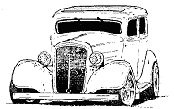The Car Toons of Pete Millar
Remembering The Father Of Arin Cee And His Comic Strips For Car Guys
Photography: Images From The Millar Family Collection And The Source Interlink Archives
A year ago, Tales from the Strip: The Hot Rod Comics and Drag Racing Cartoons of Pete Millar opened at the Pasadena Museum of California Art. It was exciting to see the work of our favorite comic book artist hanging in a fancy gallery. Although he's best known for his drag racing comics, Pete Millar was also the creator of Arin Cee, Rod & Custom's cartoon mascot in the Fifties and Sixties. Pete was born in Oakland, California in 1929. According to his wife, Orah Mae Millar, he was drawing from the time he was little and drag racing from the time he was in high school. He joined the service at 16 (his father signed papers allowing him to go). In the early Fifties he was hired as an engineer at Convair, where he met Orah Mae; they were married in 1954. Pete was making a good living drawing technical illustrations for the aerospace industry, but really wanted to make it as a cartoonist. He pitched his idea for car-themed cartoons to Hot Rod Magazine. "Don't quit your day job," they told him. At R&C, editor Spence Murray told him, "You're hired." Millar's cartoons were used to dress up our tech articles. Arin Cee made his first appearance in 1955. In 1959, Pete did what Hot Rod told him not to--he quit his day job and went into cartooning full time. He and partner Carl Kohler were contracted by Petersen Publishing to create a comic book about cars. Carl lasted one issue, but Pete produced CARtoons from his home for four years. In 1963, Petersen announced that they were taking over production of CARtoons; Pete could submit art to the new editor for consideration. Instead, he started another magazine, Drag Cartoons. In addition to laughs, Drag Cartoons provided an inside look at drag racing. Pete--who raced throughout the Sixties--knew the sport and the racers, and filled his cartoons with real cars and real people. He took some satirical jabs, but never a cheap shot--and he was always funny. His jokes were helped by his skillful caricatures. With a few pen strokes, he could draw a face as recognizable as a photo. His daughter Robin told us that racers started avoiding Pete when he had a camera, so she became his undercover photographer. "His work was a documentary of drag racing in the Sixties," Orah Mae commented. "Many racers have told me that they bought the magazine to look for themselves. They felt that if they saw themselves in a Pete Millar cartoon, they knew they'd made it." In 1968, Pete stopped drawing Drag Cartoons and moved to Europe with Orah Mae and their daughters, Robin, Debra, and April. They lived in Sweden and later in Spain, and camped their way through Finland, the Soviet Union, and several Eastern Bloc and Mediterranean countries. Pete paid the way by drawing cartoons for American magazines, picking up checks (if they showed up) at embassies wherever they went. During these years, he developed his fine art skills, making additional money selling oil paintings. For examples of Pete's more recent fine art sculptures, visit www.rodandcustommagazine.com. After returning to the U.S. in 1971, Pete introduced a variation on Drag Cartoons called Drag Comics, printed in a color newspaper format. He became a successful illustrator and model builder for court trials, where his drawings and models were used to demonstrate traffic and industrial accidents. Pete made a welcome comeback to drag racing at the 1993 NHRA California Hot Rod Reunion, and returned annually to sign autographs and sell collections of his well-loved comics. He continued to draw--never losing his sense of humor or his edge--until his death in 2003. At that year's Hot Rod Reunion, thousands of fans witnessed Bob Muravez's fuel dragster deploy its 'chutes at half-track, releasing the ashes of Pete Millar. In the years since, Orah Mae and Robin Millar have continued to attend this and other vintage drag races, promoting Pete Millar's Drag Cartoons and CD collections of his work. Their booth is a magnet for lifelong fans who loved his cartoons, and racers who loved being the object of his humor. Want More? |
Insert 1 |




